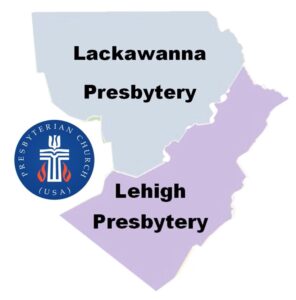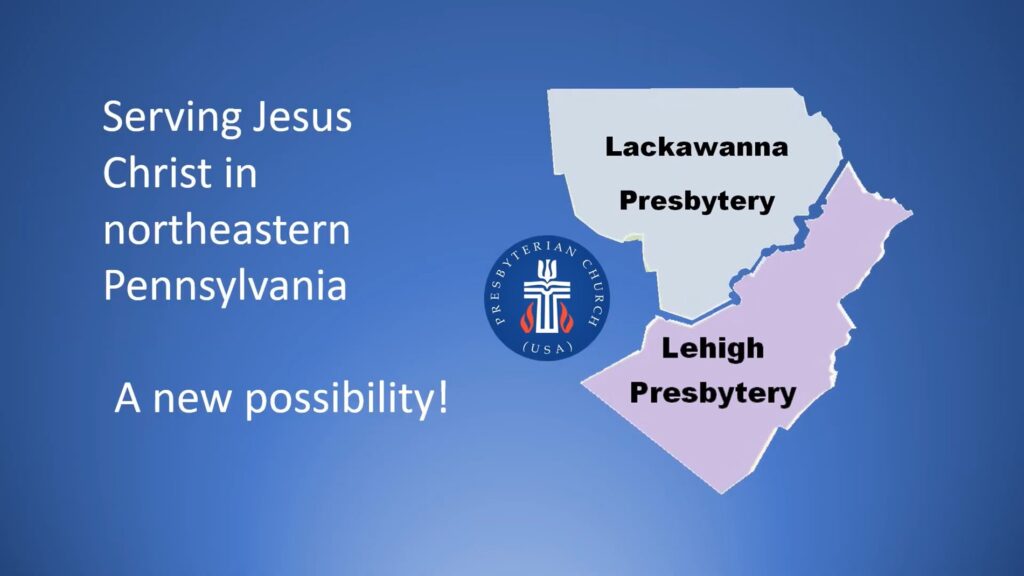 Sharing resources across presbytery lines is nothing new for Lehigh and Lackawanna. They shared a Christian education staff person for years, and in the 1990s partnered on a New Church Development in the Poconos. As far back as the late 1950s, there were discussions between the two mid councils about merging into one presbytery. Those talks have gained traction again in 2024.
Sharing resources across presbytery lines is nothing new for Lehigh and Lackawanna. They shared a Christian education staff person for years, and in the 1990s partnered on a New Church Development in the Poconos. As far back as the late 1950s, there were discussions between the two mid councils about merging into one presbytery. Those talks have gained traction again in 2024.
The two northeastern Pennsylvania presbyteries that combined stretch over 14 counties and consist of 66 congregations are in talks of merging into one mid council. Rhonda Kruse, the transitional presbytery leader for both Lehigh and Lackawanna, cited financial, programmatic and staffing benefits to the proposed union of the two regions.
“We’re getting along really well as partners,” she said. “The shared staffing is going well. It’s been helpful. We need to take the next step and go ahead and merge. There’ve been discussions. People have agreed that that’s what we need to do.”
Currently, the two presbyteries have their own stated clerks and moderators but are already sharing a transitional leader, an office administrator and a treasurer.
“What the sharing of staff has done is to alleviate the financial concerns because both presbyteries are now only paying half of the staffing costs,” Rhonda explained. “It has really significantly helped.”
At the presbyteries’ combined meeting in November, after hearing a presentation from members of the Transition Team, those gathered voted to proceed with the creation of a plan to consider the merger of the two presbyteries. This is the first step in having the merger approved, with an eventual vote by the two presbyteries and approval from the Synod of the Trinity also down the road. If the way be clear, the goal, Rhonda said, is to bring the merger plans before the 227th General Assembly of the Presbyterian Church (U.S.A.) in 2026.
“We’ve been meeting together as the two presbyteries since November of 2022,” Rhonda explained. “People are getting to know each other. Some of our committees have merged together, particularly Personnel because the staff of the two presbyteries are mostly shared staff.”
In February at a combined meeting, a video was shown that shared some of the background on the proposed merger and also gave an overview of the geography of the various mid councils in the PCUSA to help explain the purpose of the proposed collaboration. It was encouraged that the video be shared with the congregations in the two presbyteries to create a better understanding of the conversations that are occurring at the presbytery level.
Discussions for a partnership began late in 2018, a plan that also originally included Northumberland Presbytery. Rhonda was hired nearly a year later by Lehigh Presbytery as a transitional leader whose goal, among other things, was to help discern a way forward that was sustainable for Lehigh. The loss of per capita income because of a schism at the First Presbyterian Church of Bethlehem, one of the larger congregations in the presbytery, played an important role in the direction Lehigh has taken.
“They (Lehigh Presbytery) recognized that financially and people-wise they were quickly diminishing to a point where they wouldn’t be able to continue to be a presbytery serving their churches the way they should,” Rhonda recalled. “They hired me to help them figure out the way forward. It was made very clear that one of those ways would be to partner with another presbytery or two.”
Northumberland eventually dropped out of the conversations, leaving Lehigh and Lackawanna to continue the dialog. In the spring of 2022, with Lehigh’s office manager and treasurer both retiring and Lackawanna’s stated clerk taking a call elsewhere, a gap in staffing emerged and opened the door for renewed discussions about a possible partnership.
“The conversations that had been going on just weren’t going anywhere,” Rhonda said. “Lehigh reached out to the LVT (Lackawanna’s Leadership Vision Team) and said we believe this would be a good time to seriously consider a partnership because we could share staff and it would help make both presbyteries more sustainable.”
In July of 2022, Rhonda became the transitional leader for both Lehigh and Lackawanna, starting off as quarter-time for Lackawanna. In the next 12 months, her role at Lackawanna grew to the point where she was evenly splitting her time between the two presbyteries, which is where she still is today. The treasurer and office administrator have also been working a 50-50 time share between the two mid councils since the beginning of 2023. While this has been a big help, it isn’t solving all the issues facing the two regions.
“There is still an issue of sustainability in terms of volunteers to do the work of the presbyteries,” Rhonda said. “That continues to be the biggest problem for both presbyteries.”
The presbyteries’ two finance teams have met together, the Committee on Ministry chairs are in close contact with one another, clergy and CREs from both presbyteries have participated in several “mini retreats” together, and a few Lehigh volunteers have joined Lackawanna’s Congregational Empowerment Team. This shows that the collaboration is strong, and efforts are being made to make the proposed merger work.
“Significant friendships are developing among the clergy, and that’s really important,” Rhonda said. “More and more committees are coming together, and that’s very helpful because we have more people available to do the work. If we come together, that lessens the number of spaces the Nominating Committee has to fill. It widens the resources available, as far as people.”
 A merger coordinator, the Rev. Karen Kinney, has been hired to oversee the union process as a project manager for the legal, financial, ecclesiastical and relational needs of the collaboration and to make sure that deadlines are being met. Thanks to a new $30,000 Synod of the Trinity grant that is being awarded to each of its presbyteries for innovative and future-thinking projects, Lehigh and Lackawanna are combining those funds to help cover some of the costs used to hire the merger coordinator.
A merger coordinator, the Rev. Karen Kinney, has been hired to oversee the union process as a project manager for the legal, financial, ecclesiastical and relational needs of the collaboration and to make sure that deadlines are being met. Thanks to a new $30,000 Synod of the Trinity grant that is being awarded to each of its presbyteries for innovative and future-thinking projects, Lehigh and Lackawanna are combining those funds to help cover some of the costs used to hire the merger coordinator.
While a merger between Lehigh and Lackawanna appears to be the most logical move for the presbyteries, Lehigh did consider other alternatives when it began this process five-plus years ago, including dissolving and having its congregations absorbed by other neighboring presbyteries. The option that was ultimately chosen was to hire a full-time transitional presbytery leader, funding the salary package with a combination of drawing from investments and significantly raising per capita.
Even though conversations about a merger were spearheaded by Lehigh Presbytery, both Lehigh and Lackawanna will end up gaining from this partnership.
“Lackawanna recognized that they needed to do something different,” Rhonda said. “They were willing to say, ‘We’re in the same boat. Let’s see what this looks like.’
“We firmly believe this is mutually beneficial to both. We’ve been very careful not to make it seem like it’s a hostile takeover. We’ve spent a lot of time on relationships because that’s the most critical part.”
Nearly 200 driving miles separate Reading (where the southern-most congregation in Lehigh Presbytery is located) and Waverly, NY (where Valley United Presbyterian Church in Lackawanna resides). Despite the distance, which can sometimes cause personality and social differences between the communities, Rhonda feels the two regions will be able to mesh well.
“Both presbyteries have a significant proportion of their churches that are very small and/or rural,” she said. “We both have churches that are in the former coal region. There are cultural similarities in the churches in both presbyteries. Lehigh has more urban churches, but Lackawanna has Scranton and Wilkes-Barre, and they have their similarities to the larger churches in Lehigh. Culturally we’re similar enough that it seems to be working well.
“The entire state of Wyoming is a presbytery. And Utah. Other presbyteries are very geographically large, and they seemed to figure it out. The pandemic has helped us in recognizing the value of Zoom and how we can meet virtually. It’s very different, but at least for committee meetings, we are able to virtually come together in ways that just a few years ago we wouldn’t have thought about.
“For presbytery gatherings, we’re trying to center them. The geographic center for the two presbyteries together is Wilkes-Barre, so we’re trying to keep our meeting locations within 20 miles of the line so that nobody is driving from the bottom of one presbytery up to the top of another, or vice versa.”
The merger plan is comprehensive, and there’s a lot of work that needs to be done with that before the next steps can be taken. Things like leadership and committee structures and by-laws need to be ironed out before the merger can move ahead.
“Another big advantage of this is it’s going to hopefully open up some breathing room, some space, some finances to allow us to help our churches be churches of the 21st century,” Rhonda added. “It’s hopefully going to give us breathing space to reimagine how we serve our churches. Maybe it’ll even allow us to start some new ministries. It’s not just a matter of finances and committees, it also allows us to merge our resources completely in terms of imagining a new way of being a presbytery.”
A bump in the road is the fact that Rhonda is retiring at the end of August. A search team is in place and the process has been started to ideally call someone by early summer so that that person can shadow Rhonda for several weeks before fully taking over. The merger coordinator will help bridge the gap between the outgoing and incoming leaders.
It’s all a step into the unknown for the presbyteries of Lehigh and Lackawanna, a faith journey that still has some challenges ahead but one that will ultimately result in a more stable region for all to benefit.
“We started having these conversations in the fall of 2019,” Rhonda concluded. “Then the pandemic happened. We kept trying to imagine what a partnership would look like. Then in the spring of ’22, the Holy Spirit opened it up for us and made it clear that here’s what you do: you share staff, and that’s a starting point. It all became clear to us at that point.
“We have the right people who have answered the call to be part of this. We have really good leaders who are involved in helping this move forward. God’s been guiding them to step forward as well as the presbyteries as a whole to say, ‘Yeah, this is probably what you’re supposed to do.’”
